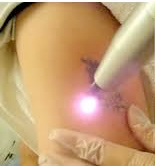 Tattoos are composed of tiny pigment particles suspended in the skin. The ink does not fade from the skin because these pigment particles are too large to be attacked by the body’s own immune system.
Tattoos are composed of tiny pigment particles suspended in the skin. The ink does not fade from the skin because these pigment particles are too large to be attacked by the body’s own immune system.
Laser treatment works by shattering these particles into smaller bits so they can be removed by the body. This shattering occurs through extreme heating. The temperature of these pigment fragments increases instantly to thousands of degrees. The energy from this rapid increase is dissipated by creating a shock wave that breaks apart the pigment particle. The surrounding tissue is not damaged but merely vibrates as the shock wave passes. Once the pigment is broken up, the body can then remove the ink.
For laser treatment to be effective, the laser light must penetrate the skin deep enough to heat the tattoo pigment. Also, the energy of the light frequency must be absorbed by the tattoo pigment more than the surrounding skin. Additionally, the sequence of the laser light must be absorbed by the tattoo pigment much more than the surrounding skin. The length of time of the laser pulse must be extremely short, in nano seconds, so that the pigment is fragmented, but the surrounding skin is not burned. And, the laser must possess enough power to heat the pigment to fragmentation, but not too much to burn the surrounding tissue.
